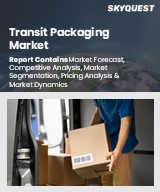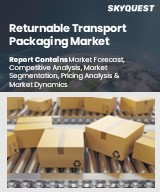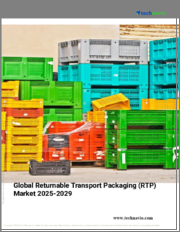
|
시장보고서
상품코드
1785632
운송용 포장 시장 규모, 점유율, 성장 분석, 제품 유형별, 재료별, 포장 유형별, 최종사용자별, 지역별 - 산업 예측(2025-2032년)Transit Packaging Market Size, Share, and Growth Analysis, By Product (Corrugated Boxes, Crates), By Material (Polypropylene, Polyethylene), By Packaging Type, By End User, By Region - Industry Forecast 2025-2032 |
||||||
운송용 포장 세계 시장 규모는 2023년 889억 9,000만 달러, 2024년 1,010억 달러에서 2032년에는 2,781억 7,000만 달러로 성장하고, 예측 기간(2025-2032년) CAGR은 13.5%를 보일 전망입니다.
세계 운송 포장 시장은 전자상거래 수요 증가, 국제 무역 증가, 안전하고 지속 가능한 포장 솔루션에 대한 중요성 증가로 인해 크게 성장하고 있습니다. 소비자들의 포장에 대한 안목이 높아지면서 골판지, 친환경 대체재 등 소재의 혁신이 촉진되고 있습니다. 또한, 포장 폐기물에 대한 규제의 발전과 다양한 산업 분야공급망 효율화가 시장을 더욱 촉진하고 있습니다. 선진국과 개발도상국 모두에서 포장 방법의 현대화, 특히 친환경 대체품의 제공은 성장을 유지하는 데 중요한 역할을 하고 있습니다. 이러한 요인들이 복합적으로 작용하여 소비자와 기업의 기대와 요구가 변화하고 있으며, 운송용 포장의 전망이 재구성되고 있습니다.
목차
서론
- 조사 목적
- 조사 범위
- 정의
조사 방법
- 정보 조달
- 1차와 2차 데이터 방법
- 시장 규모 예측
- 시장 전제조건과 제한
주요 요약
- 세계 시장 전망
- 공급과 수요 동향 분석
- 부문별 기회 분석
시장 역학과 전망
- 시장 개요
- 시장 규모
- 시장 역학
- 성장 촉진요인과 기회
- 성장 억제요인과 과제
- Porter의 Five Forces 분석
주요 시장 인사이트
- 중요 성공 요인
- 경쟁 정도
- 주요 투자 기회
- 시장 생태계
- 시장의 매력 지수(2024년)
- PESTEL 분석
- 거시경제 지표
- 밸류체인 분석
- 가격 분석
운송용 포장 시장 규모 : 제품별&CAGR(2025-2032년)
- 시장 개요
- 골판지상자
- 크레이트
- 팰릿
- 기타
운송용 포장 시장 규모 : 재료별&CAGR(2025-2032년)
- 시장 개요
- 폴리프로필렌
- 폴리에틸렌
- 폴리염화비닐
- 에틸렌 비닐 알코올
- 폴리에틸렌 테레프탈레이트
- 폴리우레탄
- 목재
- 금속
- 종이 및 판지
운송용 포장 시장 규모 : 포장 유형별&CAGR(2025-2032년)
- 시장 개요
- 목상
- 팰릿
- 스트랩
- 중간 벌크 컨테이너
- 골판지상자
- 컨테이너
- 카톤
운송용 포장 시장 규모 : 최종사용자별&CAGR(2025-2032년)
- 시장 개요
- 소비재
- 제3자 물류
- 의약품
- 산업기계 및 장비
- 전기 및 전자 공학
- 식품 및 음료
- 화학제품
- 건축 및 건설
- 자동차
- E-Commerce
운송용 포장 시장 규모&CAGR(2025-2032년)
- 북미
- 미국
- 캐나다
- 유럽
- 독일
- 스페인
- 프랑스
- 영국
- 이탈리아
- 기타 유럽
- 아시아태평양
- 중국
- 인도
- 일본
- 한국
- 기타 아시아태평양
- 라틴아메리카
- 브라질
- 기타 라틴아메리카
- 중동 및 아프리카
- GCC 국가
- 남아프리카공화국
- 기타 중동 및 아프리카
경쟁 정보
- 주요 5개사 비교
- 주요 기업의 시장 포지셔닝(2024년)
- 주요 시장 기업이 채택한 전략
- 최근 시장 동향
- 기업의 시장 점유율 분석(2024년)
- 주요 기업 개요
- 기업 상세
- 제품 포트폴리오 분석
- 기업 부문별 점유율 분석
- 매출 전년대비 비교(2022-2024년)
주요 기업 개요
- International Paper Company(미국)
- WestRock Company(미국)
- Smurfit Kappa Group(아일랜드)
- Amcor Plc(스위스/호주)
- DS Smith Plc(영국)
- Mondi Group(UK/Austria)
- Sealed Air Corporation(미국)
- Sonoco Products Company(미국)
- Berry Global Group, Inc.(미국)
- Pregis LLC(미국)
- Huhtamaki Oyj(핀란드)
- Packaging Corporation of America(PCA)(미국)
- Crown Holdings, Inc.(미국)
- Bemis Company, Inc.(미국)
- Stora Enso Oyj(핀란드)
- Intertape Polymer Group Inc.(IPG)(캐나다)
- Ranpak Holdings Corp.(미국)
- Storopack Hans Reichenecker GmbH(독일)
- Pro-Pac Packaging Limited(호주)
- Universal Protective Packaging, Inc.(UPPI)(미국)
결론과 제안
LSH 25.08.13Global Transit Packaging Market size was valued at USD 88.99 billion in 2023 and is poised to grow from USD 101.0 billion in 2024 to USD 278.17 billion by 2032, growing at a CAGR of 13.5% during the forecast period (2025-2032).
The global transit packaging market is experiencing significant growth driven by rising e-commerce demand, increasing international trade, and a heightened emphasis on secure and sustainable packaging solutions. Consumers are now more discerning regarding packaging options, prompting innovation in materials such as corrugated board and environmentally friendly alternatives. Additionally, evolving regulations concerning packaging waste and enhanced supply chain efficiencies across various industries are further propelling the market. The modernization of packaging methods in both developed and developing regions, particularly through the provision of greener alternatives, plays a crucial role in sustaining growth. Collectively, these factors are reshaping the transit packaging landscape, aligning with the changing expectations and needs of consumers and businesses alike.
Top-down and bottom-up approaches were used to estimate and validate the size of the Global Transit Packaging market and to estimate the size of various other dependent submarkets. The research methodology used to estimate the market size includes the following details: The key players in the market were identified through secondary research, and their market shares in the respective regions were determined through primary and secondary research. This entire procedure includes the study of the annual and financial reports of the top market players and extensive interviews for key insights from industry leaders such as CEOs, VPs, directors, and marketing executives. All percentage shares split, and breakdowns were determined using secondary sources and verified through Primary sources. All possible parameters that affect the markets covered in this research study have been accounted for, viewed in extensive detail, verified through primary research, and analyzed to get the final quantitative and qualitative data.
Global Transit Packaging Market Segments Analysis
Global Transit Packaging Market is segmented by Product, Material, Packaging Type, End User and region. Based on Product, the market is segmented into Corrugated Boxes, Crates, Pallets and Others. Based on Material, the market is segmented into Polypropylene, Polyethylene, Polyvinyl Chloride, Ethylene Vinyl Alcohol, Polyethylene Terephthalate, Polyurethane, Wood, Metal and Paper and Paperboard. Based on Packaging Type, the market is segmented into Wooden Crates, Barrels, Strapping, Intermediate Bulk Containers, Corrugated Boxes, Containers and Cartons. Based on End User, the market is segmented into Consumer Goods, Third-Party Logistics, Pharmaceuticals, Industrial Machinery and Equipment, Electrical and Electronics, Food and Beverages, Chemicals, Building and Construction, Automotive and E-Commerce. Based on region, the market is segmented into North America, Europe, Asia Pacific, Latin America and Middle East & Africa.
Driver of the Global Transit Packaging Market
The accelerating expansion of e-commerce is a significant driving force behind the global transit packaging market, as businesses strive to adapt and thrive in a competitive landscape. This surge in online shopping has heightened the demand for versatile packaging solutions that are not only durable but also lightweight and cost-effective. Consequently, retailers increasingly seek materials like corrugated boxes and protective mailers, coupled with sustainable options, to ensure the safe delivery of products to consumers. This evolving landscape is fostering innovation within the industry, presenting abundant opportunities for growth and development in transit packaging solutions.
Restraints in the Global Transit Packaging Market
The Global Transit Packaging market faces a notable constraint due to the higher manufacturing costs associated with eco-friendly packaging materials, such as compostable plastics and recycled fibers. These elevated expenses can pose a significant challenge, particularly for small and medium-sized enterprises (SMEs), which may struggle to adopt sustainable options. This cost barrier can hinder the widespread acceptance of environmentally friendly packaging solutions, despite their positive impact on sustainability and the environment. Consequently, the potential for market growth is restricted, as businesses weigh the financial implications of switching to greener alternatives against traditional packaging methods.
Market Trends of the Global Transit Packaging Market
The Global Transit Packaging market is experiencing a significant trend towards smart packaging integration, characterized by the adoption of advanced technologies such as RFID tags, QR codes, and IoT-enabled sensors. This shift enhances supply chain transparency, bolsters anti-counterfeiting measures, and facilitates real-time tracking of goods. The growing emphasis on efficient and secure logistics, particularly in sectors like e-commerce and pharmaceuticals, drives the demand for these innovative solutions. As businesses increasingly recognize the benefits of integrating smart packaging into their transit processes, the market is evolving toward more sophisticated packaging solutions that ensure product integrity and streamline operations.
Table of Contents
Introduction
- Objectives of the Study
- Scope of the Report
- Definitions
Research Methodology
- Information Procurement
- Secondary & Primary Data Methods
- Market Size Estimation
- Market Assumptions & Limitations
Executive Summary
- Global Market Outlook
- Supply & Demand Trend Analysis
- Segmental Opportunity Analysis
Market Dynamics & Outlook
- Market Overview
- Market Size
- Market Dynamics
- Drivers & Opportunities
- Restraints & Challenges
- Porters Analysis
- Competitive rivalry
- Threat of substitute
- Bargaining power of buyers
- Threat of new entrants
- Bargaining power of suppliers
Key Market Insights
- Key Success Factors
- Degree of Competition
- Top Investment Pockets
- Market Ecosystem
- Market Attractiveness Index, 2024
- PESTEL Analysis
- Macro-Economic Indicators
- Value Chain Analysis
- Pricing Analysis
Global Transit Packaging Market Size by Product & CAGR (2025-2032)
- Market Overview
- Corrugated Boxes
- Crates
- Pallets
- Others
Global Transit Packaging Market Size by Material & CAGR (2025-2032)
- Market Overview
- Polypropylene
- Polyethylene
- Polyvinyl Chloride
- Ethylene Vinyl Alcohol
- Polyethylene Terephthalate
- Polyurethane
- Wood
- Metal
- Paper and Paperboard
Global Transit Packaging Market Size by Packaging Type & CAGR (2025-2032)
- Market Overview
- Wooden Crates
- Barrels
- Strapping
- Intermediate Bulk Containers
- Corrugated Boxes
- Containers
- Cartons
Global Transit Packaging Market Size by End User & CAGR (2025-2032)
- Market Overview
- Consumer Goods
- Third-Party Logistics
- Pharmaceuticals
- Industrial Machinery and Equipment
- Electrical and Electronics
- Food and Beverages
- Chemicals
- Building and Construction
- Automotive
- E-Commerce
Global Transit Packaging Market Size & CAGR (2025-2032)
- North America (Product, Material, Packaging Type, End User)
- US
- Canada
- Europe (Product, Material, Packaging Type, End User)
- Germany
- Spain
- France
- UK
- Italy
- Rest of Europe
- Asia Pacific (Product, Material, Packaging Type, End User)
- China
- India
- Japan
- South Korea
- Rest of Asia-Pacific
- Latin America (Product, Material, Packaging Type, End User)
- Brazil
- Rest of Latin America
- Middle East & Africa (Product, Material, Packaging Type, End User)
- GCC Countries
- South Africa
- Rest of Middle East & Africa
Competitive Intelligence
- Top 5 Player Comparison
- Market Positioning of Key Players, 2024
- Strategies Adopted by Key Market Players
- Recent Developments in the Market
- Company Market Share Analysis, 2024
- Company Profiles of All Key Players
- Company Details
- Product Portfolio Analysis
- Company's Segmental Share Analysis
- Revenue Y-O-Y Comparison (2022-2024)
Key Company Profiles
- International Paper Company (USA)
- Company Overview
- Business Segment Overview
- Financial Updates
- Key Developments
- WestRock Company (USA)
- Company Overview
- Business Segment Overview
- Financial Updates
- Key Developments
- Smurfit Kappa Group (Ireland)
- Company Overview
- Business Segment Overview
- Financial Updates
- Key Developments
- Amcor Plc (Switzerland/Australia)
- Company Overview
- Business Segment Overview
- Financial Updates
- Key Developments
- DS Smith Plc (UK)
- Company Overview
- Business Segment Overview
- Financial Updates
- Key Developments
- Mondi Group (UK/Austria)
- Company Overview
- Business Segment Overview
- Financial Updates
- Key Developments
- Sealed Air Corporation (USA)
- Company Overview
- Business Segment Overview
- Financial Updates
- Key Developments
- Sonoco Products Company (USA)
- Company Overview
- Business Segment Overview
- Financial Updates
- Key Developments
- Berry Global Group, Inc. (USA)
- Company Overview
- Business Segment Overview
- Financial Updates
- Key Developments
- Pregis LLC (USA)
- Company Overview
- Business Segment Overview
- Financial Updates
- Key Developments
- Huhtamaki Oyj (Finland)
- Company Overview
- Business Segment Overview
- Financial Updates
- Key Developments
- Packaging Corporation of America (PCA) (USA)
- Company Overview
- Business Segment Overview
- Financial Updates
- Key Developments
- Crown Holdings, Inc. (USA)
- Company Overview
- Business Segment Overview
- Financial Updates
- Key Developments
- Bemis Company, Inc. (USA)
- Company Overview
- Business Segment Overview
- Financial Updates
- Key Developments
- Stora Enso Oyj (Finland)
- Company Overview
- Business Segment Overview
- Financial Updates
- Key Developments
- Intertape Polymer Group Inc. (IPG) (Canada)
- Company Overview
- Business Segment Overview
- Financial Updates
- Key Developments
- Ranpak Holdings Corp. (USA)
- Company Overview
- Business Segment Overview
- Financial Updates
- Key Developments
- Storopack Hans Reichenecker GmbH (Germany)
- Company Overview
- Business Segment Overview
- Financial Updates
- Key Developments
- Pro-Pac Packaging Limited (Australia)
- Company Overview
- Business Segment Overview
- Financial Updates
- Key Developments
- Universal Protective Packaging, Inc. (UPPI) (USA)
- Company Overview
- Business Segment Overview
- Financial Updates
- Key Developments



















